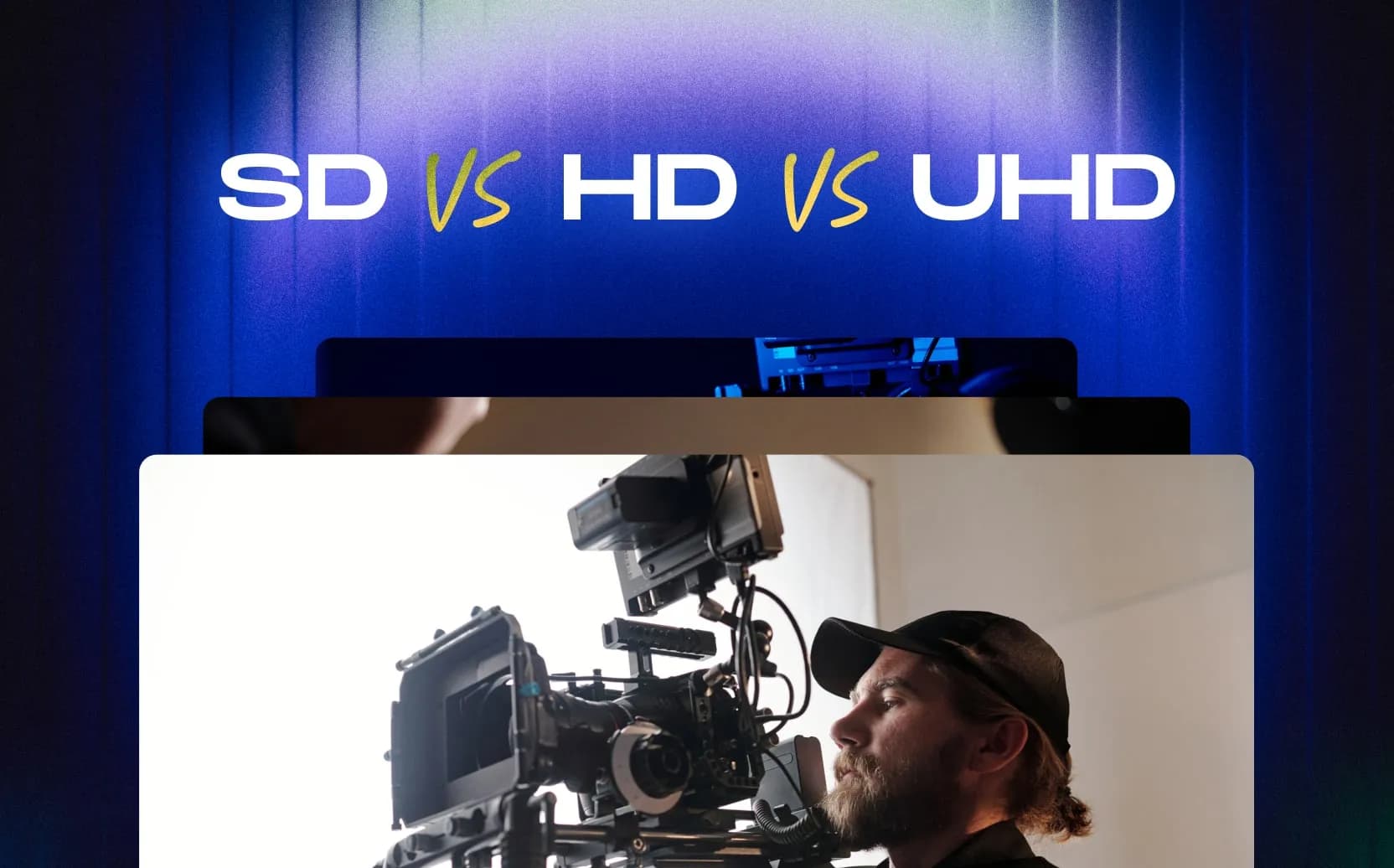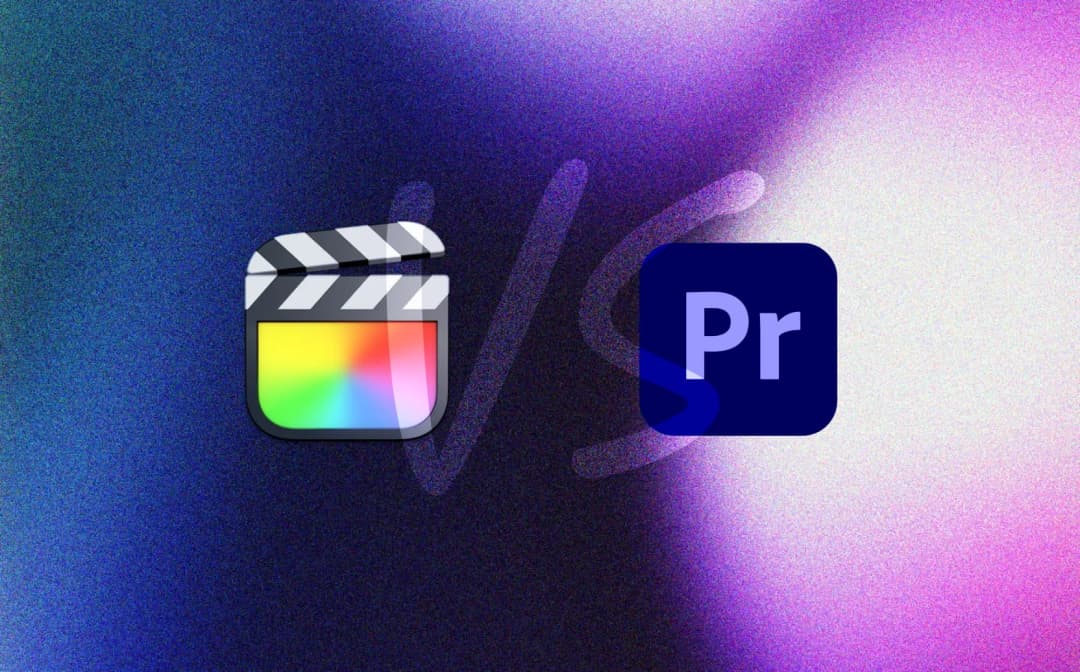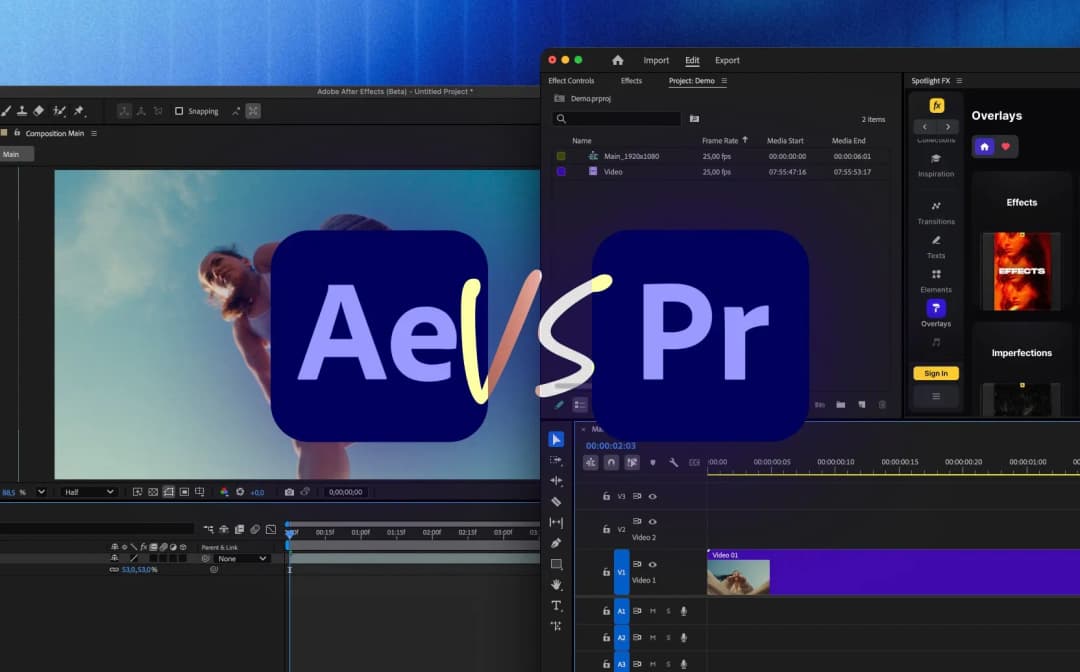SD vs HD vs UHD: What Video Editors Actually Need to Know
|
11 mins
|
Apr 16, 2025

- First Up: What Even IS Resolution?
- SD (Standard Definition)
- HD (High Definition)
- UHD (Ultra High Definition) / 4K
- So, SD vs HD vs UHD: The Showdown
- Why This Matters For You, The Editor
- Resolution Cheat Sheet from SD to 12K
- Quick FAQ: Your Resolution Questions Answered
- Wrapping It Up
- Spotlight FX - Get free transitions, effects and workflow tools
Okay, let's talk pixels. No, not the movie (though that was... something), but the tiny little dots that make up the videos we spend hours editing. You've probably seen the letters SD, HD, and UHD thrown around a lot. Maybe a client asked for "HD delivery," or you saw options like SD vs HD when buying a movie on Amazon Prime Video. It can get confusing, especially when you're just trying to get your timeline settings right in Premiere Pro.
So, what's the actual difference between HD and SD? And where does UHD fit in? As editors, knowing this stuff isn't just trivia, it actually impacts our workflow, from sequence settings to export times, and even how smoothly things play back. I work in Premiere Pro and After Effects daily, dealing with footage of all shapes and sizes, so trust me, getting a handle on resolution makes life easier. Let's break down HD vs SD video (and UHD!) in plain English.
First Up: What Even IS Resolution?
Think of a video screen like a grid. Resolution basically tells you how many tiny squares (pixels) fit into that grid, horizontally and vertically. More pixels mean more detail, which generally means a sharper, clearer image. Fewer pixels? Things can start to look a bit blocky or blurry, especially on bigger screens. Simple enough, right?
SD (Standard Definition)
Alright, let's start with SD, or Standard Definition. This is the resolution most of us grew up with if you watched TV before the mid-2000s or used DVDs.
What is SD resolution?
It varies slightly, but common ones are 720x480 pixels (for NTSC, the standard used in North America and Japan) or 720x576 pixels (for PAL, used in Europe, Australia, and other parts of the world). You might also see it referred to as 480p or 576p sometimes.
SD Meaning: Standard Definition. It was the standard... until HD came along.
The Vibe: Think old camcorder footage, standard DVDs, maybe some early YouTube videos. On modern high-resolution monitors or TVs, SD footage looks noticeably soft or even pixelated. The detail just isn't there compared to what we're used to now.
Why You Still Encounter It: Sometimes clients hand over ancient footage ("Can you use this tape from my wedding in 1998?"). You might find archival clips online are only available in SD. Very occasionally, a specific niche platform might still require SD uploads, though that's becoming rare.
In Premiere Pro: You'll see SD sequence presets (like DV NTSC or DV PAL). If you drop SD footage into an HD timeline, you'll need to scale it up, which often makes the lack of detail more obvious. Exporting to SD is easy, but usually not the goal unless you have a very specific reason.
Honestly, you probably won't be aiming to work exclusively in SD unless you have a retro project or specific constraints. Its main relevance today is usually dealing with older source material.
HD (High Definition)
HD, or High Definition, was a huge leap from SD and is now the baseline for most video work. When someone says HD vs SD, the difference is pretty dramatic.
What is HD resolution? There are two main flavors:
- HD (or 720p): 1280x720 pixels. This was an early HD standard. Still used sometimes, but less common than Full HD.
- Full HD (or 1080p): 1920x1080 pixels. This is the most common HD resolution you'll encounter. It's the standard for Blu-rays, most online streaming (YouTube, Vimeo often default here), and a lot of broadcast TV.
Quick Note on 'p' vs 'i':You might see 1080p (progressive) or 1080i (interlaced). Progressive scans the whole image at once, giving a smoother look for motion. Interlaced scans odd and even lines separately, an older technique used to save bandwidth in broadcasting. For online video and most modern editing, you'll almost always want to work in progressive (p). Don't worry too much about 'i' unless you're specifically working with older broadcast footage.
The Vibe: Much sharper and more detailed than SD. This is probably what you're shooting on your DSLR, mirrorless camera, or even a good smartphone. It looks crisp on most computer monitors and TVs.
Why It's Everywhere: It hit the sweet spot between quality and file size/manageability for a long time. It looks good, doesn't require a supercomputer to edit (usually), and file sizes are reasonable.
In Premiere Pro: This is likely your default. Sequence presets for 1080p at various frame rates (23.976, 25, 29.97, 59.94) are standard. Editing 1080p footage is generally smooth on moderately powerful machines. Exporting in 1080p is probably what you do most often for web delivery.
HD (especially 1080p) is the comfortable middle ground. It's what most clients expect as a minimum these days.
UHD (Ultra High Definition) / 4K
Now we get to the really high-resolution stuff. UHD, or Ultra High Definition, often gets lumped together with 4K, and for most practical purposes in editing, they're very similar.
What is UHD vs HD? It's a massive jump in pixels.
- UHD (Ultra HD): 3840x2160 pixels. Notice this is exactly double the horizontal and double the vertical pixels of Full HD (1920x1080), meaning it has four times the total pixels. This is the standard for 4K TVs and much 4K streaming content (like on Netflix or Prime Video where you see SD vs HD vs UHD options).
- DCI 4K (Cinema 4K): 4096x2160 pixels. This is slightly wider than UHD and is often used in digital cinema production. Your camera might shoot this, but UHD (3840x2160) is more common for final delivery to consumers.
The Vibe: Incredibly detailed. If you have a 4K screen, the difference between HD and UHD/4K can be noticeable, especially up close. Images look extremely sharp, and you can see fine textures.
Why Use It?
Future-Proofing: Delivering in 4K means your content looks its best on the latest screens.
Reframing/Cropping: This is a big one for editors. If you shoot in 4K but deliver in 1080p HD, you have a ton of extra pixels to play with. You can effectively 'zoom in' or reframe your shot in post-production without losing HD quality. Need to turn a wide shot into a medium? Easy. Need to stabilize a slightly shaky shot digitally? 4K gives you more data to work with for tools like Warp Stabilizer in Premiere Pro.
High-End Productions: Required by many streaming services like Netflix for original content.
The Catch (Workflow Pain Points):
File Sizes: 4K footage takes up way more storage space than HD. Get ready for bigger hard drives!
Editing Demands: Editing 4K smoothly requires a powerful computer (good CPU, lots of RAM, and especially a capable GPU). Trying to edit native 4K on an older or lower-spec machine can be painful – think choppy playback, slow rendering. This is where proxy workflows in Premiere Pro become absolutely essential. (Proxies are lower-resolution stand-in files you edit with, then swap back to the full-res 4K for export).
Export Times: Rendering and exporting 4K projects takes significantly longer than HD.
In Premiere Pro: You'll find UHD sequence presets. If your machine struggles, immediately look into creating proxies (right-click footage > Proxy > Create Proxies). When exporting, be prepared for it to take a while.
So, SD vs HD vs UHD: The Showdown
Let's quickly summarize the difference between SD, HD, and UHD:
- SD (Standard Definition): ~720x480 or 720x576 pixels. Old standard, looks blocky now. Rarely used except for archival footage.
- HD (High Definition): 1280x720 (720p) or 1920x1080 (1080p/Full HD). The current common standard, good quality, manageable workflow.
- UHD (Ultra High Definition) / 4K: 3840x2160 (UHD) or 4096x2160 (DCI 4K). Very high detail, great for reframing, but demands powerful hardware and lots of storage.
Think of it like zooming in on a digital photo. SD is like looking at the whole photo zoomed out. HD is zooming in a bit, seeing more detail. UHD/4K is zooming way in, seeing individual threads or textures.
Why This Matters For You, The Editor
Okay, knowing the numbers is one thing, but how does this SD vs HD vs UHD stuff actually affect your day-to-day editing?
- Matching Sequence Settings: This is crucial. Always try to set your Premiere Pro sequence settings to match the majority or the highest quality footage you have, especially if you're delivering in that format. If you have 4K footage and plan to deliver in 4K, use a 4K sequence. If you drop 1080p footage into a 4K sequence, it will look small until you scale it up. If you drop 4K footage into a 1080p sequence, Premiere will ask if you want to change the sequence settings or keep them. Usually, you'll keep the 1080p settings if that's your target delivery format, allowing you to use that extra 4K resolution for reframing. Using mismatched settings without understanding 'Scale to Frame Size' vs 'Set to Frame Size' can lead to black bars or unexpected quality loss. (Generally, 'Set to Frame Size' is better if you want to potentially reframe later, 'Scale to Frame Size' just makes it fit).
- Exporting Correctly: Your client asks for HD? That usually means 1080p (1920x1080). Delivering for YouTube? 1080p is great, 4K is even better if you shot it and your audience has 4K screens. Delivering for Instagram Reels? That's a vertical format (like 1080x1920). Knowing the target resolution is key to choosing the right export preset in Premiere Pro or Media Encoder. Exporting 4K footage as SD will look terrible. Exporting SD footage as 4K won't magically add detail, it'll just make the existing pixels bigger.
- Understanding Clients: When a client says "Can I get this in HD?", clarify if they mean 720p or 1080p (usually 1080p). If they ask for 4K, make sure they understand the potential file size and if they actually need it. Sometimes clients ask for 4K just because it sounds fancy, without realizing their primary viewing platform might only support 1080p. Managing expectations is part of the job!
- Performance & Proxies: As mentioned, editing 4K (and even some complex HD projects with lots of effects in After Effects linked comps) can bring your system to its knees. Understanding that higher resolution = more processing power needed helps you plan. If you know you'll be working with 4K, build proxy creation time into your workflow estimate. Don't wait until playback is already stuttering! It feels like an extra step at first, but trust me, proxies save so much frustration on heavy projects. Once you’ve tried it a couple of times, it’ll feel much easier.
- Storage Space: Higher resolution means bigger files. A minute of 4K footage takes up way more space than a minute of HD or SD. Plan your storage accordingly. External SSDs are great for active projects, larger HDDs for archive.
Resolution Cheat Sheet from SD to 12K
Okay, we've thrown a lot of letters and numbers around! To make it easier to see how everything compares, here’s a quick reference table. It lines up the common resolutions (and some seriously high-tech ones!), showing the pixel power, common shape (aspect ratio), and where you usually find them. Think of it as your go-to guide!
Common Name(s) / Acronym | Pixel Dimensions (Width x Height) | Aspect Ratio | Total Pixels (Approx.) | Typical Uses / Devices |
|---|---|---|---|---|
SD (Standard Definition) | 640x480 / 720x 480/576 | 4:3 / ~16:9 | ~0.3 Megapixels | Old tube TVs, VHS tapes, DVDs, very low-quality streaming |
HD / 720p | 1280x720 | 16:9 | ~0.9 Megapixels | Early HDTVs, some broadcasts, basic streaming quality, smaller web content |
Full HD (FHD) / 1080p | 1920x1080 | 16:9 | ~2.1 Megapixels | Standard HDTVs, Blu-rays, most streaming services, computer monitors, smartphone screens |
QHD / 1440p / 2K | 2560x1440 | 16:9 | ~3.7 Megapixels | Gaming monitors, high-end smartphones, step-up from FHD monitors |
DCI 2K | 2048x1080 | ~1.9:1 (256:135) | ~2.2 Megapixels | Digital cinema projection standard |
UHD / 4K / 2160p | 3840x2160 | 16:9 | ~8.3 Megapixels | Modern TVs, 4K Blu-rays, premium streaming, computer monitors, game consoles, many modern cameras |
DCI 4K | 4096x2160 | ~1.9:1 (256:135) | ~8.8 Megapixels | Professional cinema projection standard |
5K | 5120x2880 | 16:9 | ~14.7 Megapixels | High-end computer monitors (e.g., iMac Retina), some pro cameras (stills), allows viewing 4K with toolbars |
6K | ~6144x3160 / ~6144x3456 | ~1.94:1 / 16:9 | ~19-21 Megapixels | Professional cinema cameras (RED, Blackmagic), high-end displays, VFX work |
UHD 8K / 4320p | 7680x4320 | 16:9 | ~33.2 Megapixels | High-end TVs, professional cameras (Canon R5, Nikon Z9), specialized displays, future-proofing, VFX reframing |
DCI 8K | 8192x4320 | ~1.9:1 (256:135) | ~35.4 Megapixels | Professional cinema cameras, high-end cinematography, digital cinema mastering |
10K | ~10240x4320 (Often wider) | Varies (~2.37:1 common) | ~44 Megapixels+ | Highly specialized displays/cameras, extreme detail capture for cropping/VFX flexibility |
12K | 12288x6480 | 1.9:1 (Native Sensor) / 16:9 (Cropped) | ~79.6 Megapixels | Very high-end pro cinema cameras (Blackmagic URSA 12K), extreme detail capture for VFX |
(Aspect ratios are approximate or typical; variations exist, especially in cinema and specialized displays/cameras).
(P.S. Wondering about "DCI" in the table? It just means Digital Cinema Initiatives – a movie industry group setting standards for digital cinemas. Their resolutions are geared for professional theaters and differ a bit from the UHD versions on TVs.)
Quick FAQ: Your Resolution Questions Answered
Let's hit some of those specific questions you might have Googled:
Q: What is SD vs HD?
A: This all boils down to resolution. SD (Standard Definition) has fewer pixels (like 720x480), resulting in a less detailed image compared to HD (High Definition), which typically means 1920x1080 pixels (Full HD) for a much sharper picture.
Q: What is UHD vs HD vs SD?
A: It's a ranking of resolution and detail: SD is the lowest, HD is in the middle (much better than SD), and UHD (often called 4K) is the highest (four times the pixels of Full HD), offering the most detail.
Q: What do SD and HD stand for?
A: SD stands for Standard Definition. HD stands for High Definition. The terms refer to the resolution standards and the resulting image quality.
Q: What's the difference between HD video and SD video?
A: HD video (High Definition, usually 1080p) has significantly more pixels and therefore much better clarity, sharpness, and detail than SD video (Standard Definition, e.g., 480p).
Q: What is SD vs HD resolution?
A: SD resolution is typically around 720x480 or 720x576 pixels. HD resolution is usually 1280x720 (720p) or, more commonly, 1920x1080 (1080p) pixels. UHD (4K) resolution is 3840x2160 pixels.
Wrapping It Up
Okay, so SD, HD, UHD, 4K, 1080p, 720p... it's a bit of an alphabet soup, isn't it? But basically, it all comes down to pixels. More pixels generally mean a sharper image, but also bigger files and more work for your editing computer.
- SD: Old news, low detail.
- HD (1080p): The current workhorse standard. Good quality, manageable.
- UHD/4K: Highest detail, great for flexibility (reframing!), but needs beefy hardware and storage.
Understanding the difference between HD and SD, and where UHD fits in, is super important for us editors. It helps us set up projects correctly in Premiere Pro, manage client expectations, choose the right export settings, and plan our workflows (hello, proxies!).
Denis Stefanides
About the author
Related Posts
%20vs%20H.264%20(AVC).webp&w=1080&q=75)
Denis Stefanides
15 mins

Denis Stefanides
15 mins

Denis Stefanides
10 mins
